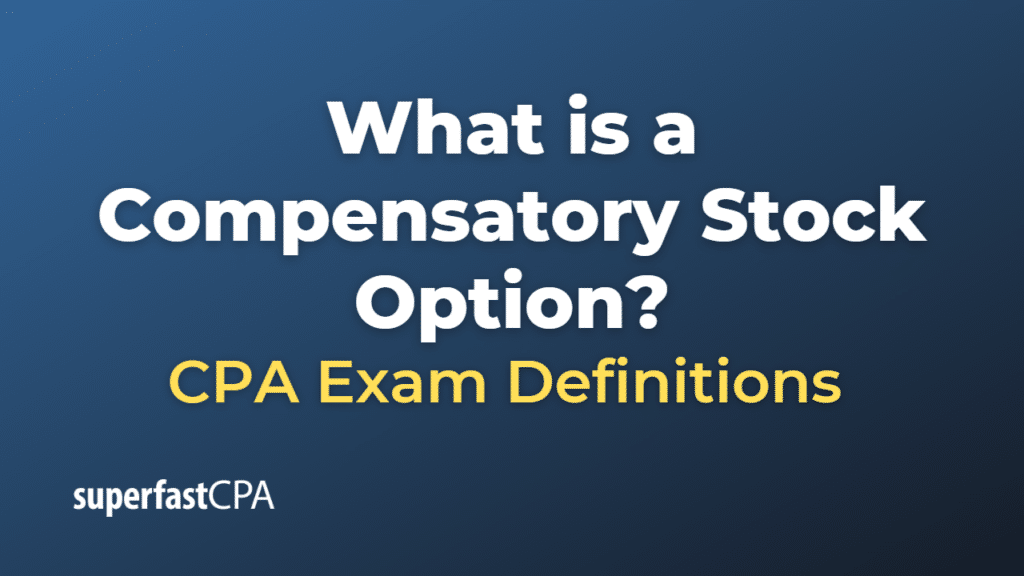Compensatory Stock Option
A compensatory stock option is a type of equity-based compensation that grants employees the right to purchase a specific number of shares of the company’s stock at a predetermined price (called the exercise or strike price) after a specified vesting period. Compensatory stock options are typically offered to employees as a part of their overall compensation package to incentivize and reward their performance, align their interests with those of the company’s shareholders, and encourage long-term commitment to the organization.
Compensatory stock options can be classified into two main types:
- Incentive Stock Options (ISOs): ISOs are stock options that receive preferential tax treatment under the Internal Revenue Code in the United States. They are only available to employees (not consultants or independent contractors) and must meet specific requirements, such as a maximum term of 10 years and an exercise price that is equal to or greater than the fair market value of the stock at the time of the grant. Gains from the sale of ISOs are typically taxed as long-term capital gains, provided certain holding period requirements are met.
- Non-qualified Stock Options (NSOs): NSOs are stock options that do not meet the requirements for ISOs and do not receive preferential tax treatment. NSOs can be granted to employees, consultants, and independent contractors. When NSOs are exercised, the difference between the exercise price and the fair market value of the stock at the time of exercise is generally considered ordinary income and subject to taxation.
A compensatory stock option typically has a vesting schedule that outlines when the options become exercisable. The vesting period often ranges from one to four years, with options becoming exercisable incrementally over time. Once the options are vested, the employee can exercise them, purchase the company’s stock at the exercise price, and potentially sell the shares for a profit if the stock’s market price has increased since the grant date.
Compensatory stock options can be an attractive form of compensation for employees, as they provide the opportunity to participate in the company’s growth and success and potentially generate significant wealth if the company’s stock price appreciates over time.
Example of a Compensatory Stock Option
Let’s consider a hypothetical example of a compensatory stock option granted to an employee named John, who works as a software engineer at TechABC, a technology company.
TechABC offers John a compensatory stock option package as part of his overall compensation. The details of the stock option package are as follows:
- Type of stock option: Non-qualified Stock Option (NSO)
- Number of options granted: 2,000
- Exercise (strike) price: $10 per share (the fair market value of TechABC’s stock at the time of the grant)
- Vesting schedule: 4-year vesting with a one-year cliff, followed by monthly vesting
- After one year of employment (the cliff), 25% of the options (500) will vest.
- After the first year, the remaining 75% (1,500) will vest monthly over the next three years (1,500 / 36 = 41.67 options per month).
Assuming John remains employed at TechABC, let’s consider two possible scenarios when he decides to exercise his options after the four-year vesting period:
Scenario 1: TechABC’s stock price has increased to $30 per share.
- John exercises all 2,000 vested options and purchases 2,000 shares at the exercise price of $10 per share, for a total cost of $20,000.
- The fair market value of the 2,000 shares at the time of exercise is $60,000 (2,000 x $30).
- John’s profit (before taxes) is $40,000 ($60,000 – $20,000).
- The $40,000 profit will be treated as ordinary income and subject to taxation.
Scenario 2: TechABC’s stock price has decreased to $8 per share.
- In this case, John’s options are “underwater,” meaning the exercise price is higher than the current market price of the stock.
- John would not benefit from exercising his options, as it would cost him more to purchase the shares ($10 per share) than their current market value ($8 per share).
- John may choose not to exercise his options and wait to see if the stock price increases in the future, or let the options expire if the stock price never rises above the exercise price.
This example demonstrates how compensatory stock options can provide employees with the opportunity to participate in the company’s growth and potentially generate significant wealth if the stock price appreciates over time. However, the example also highlights that stock options carry a risk, as the stock price may decrease or remain below the exercise price, rendering the options less valuable or even worthless.













